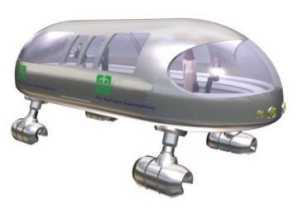It's gone under several names: HyRail, Hydrogen Superhighway, and Interstate Traveler. It's been accused of being "sci-fi". It's a transportation system, it produces and distributes electricity and hydrogen fuel. It won't cost the government a penny, but it will provide millions of jobs. It's the brainchild of Justin Sutton. Unfortunately, it's still a dream.

What is it really? In a nutshell:
- Transportation: maglev vehicles of various sizes will travel along pairs of rails containing superconducting magnets
- Energy: a central conduit covered with solar panels will generate power to move the vehicles, while extra power will be converted to hydrogen using electrolysis; the hydrogen will be used to generate electricity to run the system during the dark hours, so it will be entirely self-powering
- Distribution: pipes in the conduit will carry water for electrolysis, hydrogen to storage, fiber optic cables for communication, and large amounts of electricity using the supercooled pipes needed for magnetic levitation
- Where: along existing rights of way - highways or railways; the tracks are elevated maybe 15-30 feet above the ground
- Financing: Revenue is expected from generating and distributing energy as well as from farebox, and will be shared 50/50 with right of way owners; the economic model looks very promising
- Environment: produces zero greenhouse gasses, and being elevated, has a very small footprint on the ground
- Vehicles: can be made by any company that meets the ISO specifications now being drafted
- Speed: the goal is to top out at about 180 MPH.
- Manufacturing: could be anywhere, but Interstate Traveler LLC is based in Michigan, so Justin says they'll be starting in Michigan.
What's not to like about this plan? Absolutely nothing, the way Justin tells it. Several Michigan legislators are supportive; State Senator Valde Garcia (R-Livingston) and State Reps Bill Rogers (R-Livingston/Oakland) and Mike Huckleberry (D-Montcalm/Ionia) held a hearing on the energy implications of the system this morning at the University of Michigan. All were positive about the proposal. Politically, it's a sure win: no tax money to be allocated, but possible revenue and jobs to be gained.
I was skeptical when I went to the hearing, and remain skeptical after attending. Not opposed in any way. It all sounds so good, I just have to ask, is it too good to be true? The concepts are great. The math seems solid, both the physics and the finances. The assumptions appear conservative. The graphics are cool.
But there are no prototypes. Nothing has been tested against reality. Computer models are fine, but they're talking about lots of stuff that has never been put together before. Solar panels are reliable; hydrolysis has been used a long time to make hydrogen; superconducting magnetic levitation is in commercial - but limited - use; elevated guideways have been used reliably in many places. But these technologies have never been put together, and never on this scale. There are no working models or prototypes of the proposal, not even a quarter kilometer of track has been built, let alone tested.
So a lot of up-front work still has to be done before this will rise to a confidence-level that will attract private funds. Justin is avoiding public funds, even for R&D. More power to him! But can he attract funds from cautious private investors without anything more than cool pictures and computer models? That's the big question now.
Good luck, Justin!
Check out the company's Web site for yourself. What do you think?




